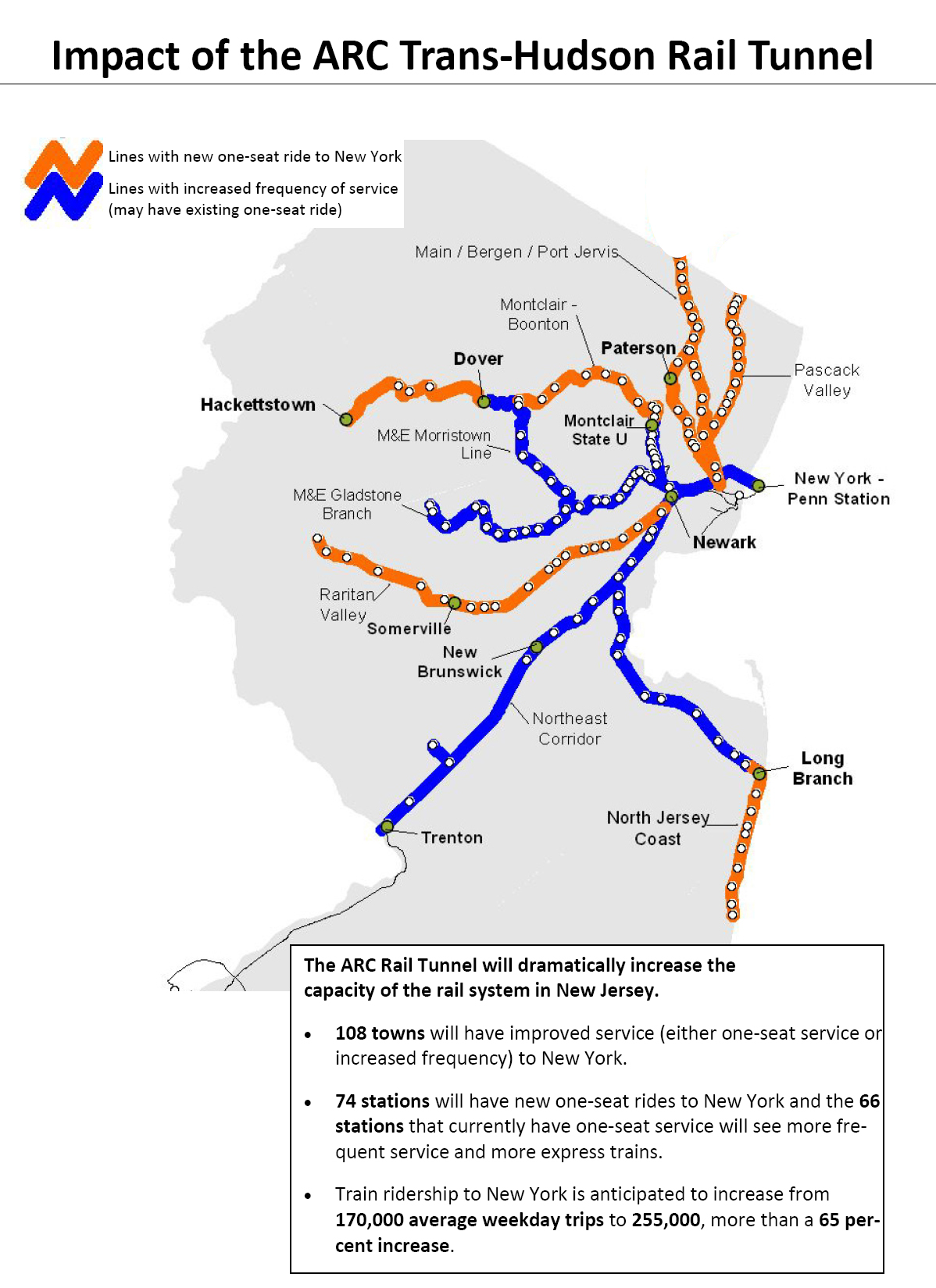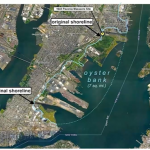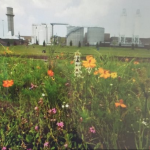New Jersey Future Blog
New Tunnel Could Transform NJ’s Landscape … And Brighten its Economic Prospects
July 6th, 2010 by Jay Corbalis
- Ridership on NJ Transit’s rail network has quadrupled since 1984, and is forecast to double again over the next 20 years. Even with the recent addition of new double-decker trains, NJ Transit cannot expand service between New Jersey and New York City because the Hudson River tunnel, completed in 1910, has reached its capacity.
- The Access to the Region’s Core (ARC) Trans-Hudson Express Tunnel project will add a new rail tunnel (actually two new, single-track tunnels) under the Hudson River to a new passenger station adjacent to the existing Penn Station, more than doubling peak-hour capacity from 23 to 48 trains per hour.
- At a cost of $8.7 billion, the ARC tunnel is the largest transit infrastructure project in the nation. The cost will be shared among the Port Authority of New York and New Jersey ($3 billion), the federal government ($3 billion) and the State of New Jersey ($2.7 billion).
- When the project and its related improvements are completed, 66 NJ Transit stations will see service improvements, while 74 stations will gain a one-seat ride to Manhattan, making many of these stations a magnet for transit-oriented development.
Better Transit Service Linked to Smarter Growth
New Jersey has one of the most extensive passenger rail networks in the nation, with an estimated 70 percent of its population living within five miles of a train station. Transit ridership in the state has grown 45 percent between 1997 and 2007, compared with a 20 percent increase in driving, and is projected to double over the next 20 years. Many of these riders will be traveling to New York City (one out of every 15 employed New Jerseyans works in Manhattan), and accommodating them will require adding more capacity under the Hudson River.
The ARC tunnel project will allow NJ Transit to accommodate the projected growth in ridership. Because there is no room to increase the number of tracks coming into Penn Station, the tunnel, which will be used exclusively by NJ Transit, will connect to a new station, adjacent to the current Penn Station beneath 34th Street with underground connections to Penn Station and Herald Square. And because New York City’s Water Tunnel No. 1, which supplies water to all of Manhattan south of 79th Street, blocks the eastward expansion of the ARC tunnel, it cannot currently be extended to Grand Central Station or other points east. (A new water tunnel is under construction, and should be completed by 2020; at that point, it will be possible to extend the ARC tunnel eastward).
As with any project of this magnitude, the ARC tunnel has its detractors. The cost of the project, its design (in particular the depth of the new station) and Amtrak’s potential interest in constructing a third trans-Hudson tunnel to add capacity along its Northeast Corridor line are all cited as reasons not to move forward quickly on the project. But Amtrak’s planning horizon is at least two decades behind New Jersey’s; the new station will be no deeper below ground than the Long Island Railroad’s East Side Access station or some of the stations on Washington D.C.’s Metro, and there are no other options; and with the federal government and the Port Authority footing a majority of the bill, New Jersey stands to reap substantial benefit in return for shouldering its share of the cost of the ARC project.
From both a transportation planning perspective and an economic perspective, it is clear that adding capacity between New Jersey and New York City is essential — and after 15 years of study by a range of experts, the ARC tunnel proposal was concluded to be the best, and most feasible, way to accomplish this. But the real value of the ARC project won’t be measured in peak-hour passenger trips. It will be measured in the new development spurred by ARC: compact, walkable development centered around existing train stations that will allow the most densely populated state in the nation to accommodate new residents without further crowding its highways or paving over its remaining open space.
In the same way that the Interstate Highway system played a major role in shaping growth and development patterns for more than 50 years, the ARC tunnel, and the resulting service expansions and improvements, has the potential to fundamentally alter New Jersey’s landscape in the coming decades. A study of the earlier “Midtown Direct” improvement, which provided a one-seat ride to New York from many New Jersey stations for the first time, found that the new service led directly not only to substantial increases in ridership, but also to higher property values near these stations. This phenomenon, combined with the larger market and demographic trends driving demand for jobs and housing in compact neighborhoods near transit, underpins the critical role the tunnel will play in attracting private investment and economic growth to New Jersey.


















No question the ARC tunnel is expensive and its connections in New York less than perfect. But those making decisions on this tunnel in 2010, including not just officials but citizens as well, should bear in mind the forethought of those who came before us. The existing tunnel, just now reaching capacity, opened 100 years ago. Surely the current generation of decision-makers has some obligation to act with the breadth and depth of vision of those who went before us –4 generations ago.
This tunnel, as presently conceived, will go into its own $3 billion dead-end station under 34th St, not Penn Station NY (PSNY). For the foreseeable future, Amtrak and Metro-North will not be able to use it. I think that will be a tragic waste of money, the mistake of the century.
Furthermore, trains will have to back out of the dead-end station to return to New Jersey. There would be none of the benefits of creating and expanding regional and national services.
As this writing, there is still time to correct course to PSNY and cooperate with Amtrak to complete a project mutually beneficial to all.
As for connecting New Jersey to Grand Central Station, there is also the practical, cost-effective option of extending NYC’s midtown No. 7 subway line west to Weehawken (Lincoln Harbor) and Secaucus Transfer. See http://www.SubwayToSecaucus.com for more details.
Steve Lanset
Transportation Issues Coordinator
New Jersey Sierra Club
Steve,
Thanks for the thoughtful feedback. Though a tunnel running through to Sunnyside and points eastward would be ideal, New York’s Water Tunnel #1 currently makes that impossible, as we note in the Future Facts. Once that tunnel is replaced, the ARC tunnel could indeed be extended eastward.
As for linking up to Amtrak/Penn Station, the current Penn Station is at capacity and could not accommodate the influx of riders that the tunnel is being built for, nor could a renovated Moynihan station. Amtrak will gain the use of several peak hour slots in the existing tunnel, which will improve their capacity in and out of NYC.
Jay
In the map accompanying the story, I’d like to suggest that the additional trackage being restored over the “Lackawanna Bypass” right-of-way (westward from Lake Hopatcong to Andover, Blairstown, and Pennsylvania stops) be included.
The purpose of the map was to show the effects of the ARC tunnel on existing service. The Lackawanna Cutoff’s hypothetical station stops are at present not part of the existing NJT rail network, so they were not appropriate to include on the map.
Tim [the creator of the map]
[…] Jersey Future has long been a supporter of the ARC tunnel project, not just for its value as a transportation project, but also as a […]
[…] long-term economic growth in New Jersey. From a smart-growth perspective, the ARC project presents enormous development and redevelopment opportunities around New Jersey train stations. Governor Christie has ordered a 30-day review of ARC while his […]
[…] constraints, but would also forego billions in federal aid and cripple New Jersey’s ability to spur sustainable, transit oriented development in its most populated […]
it is quite sad that most train stations these days are horrendously overloaded :
Dear Sir
HONGKONG KOON TECHNOLOGY LTD is a leader in the research and development, manufacture and sales of Industrial series telephone products.
We would like to cooperate with you either OEM or ODM business on our phones for a very long time.
Our Major products are Special Industrial telephone: Waterproof telephone, Loud speaker weatherproof telephone, Bank telephone, Tunnel emergency telephone, Elevator telephone, Prison telephone, etc. Applicable for Subway, Railway, Highway call box, Tunnel, Power plant, Petrochemicals factory, Mining, Dockside, iron & steel factory,bank system,etc.
More info pls visit our web site http://www.koontech.com
Pls feel free to contact me if you are interesting,TKS!
Tags:telephone/phone system, telecommunications, industrial phones/telephone, public phone, SoS phone, bank service phone, tunnel phone, elevator phone, loudspeaker phone/telephone, waterproof phone, weatherproof phone, emergency(help) phone, hand-free phone, prison phone, etc.